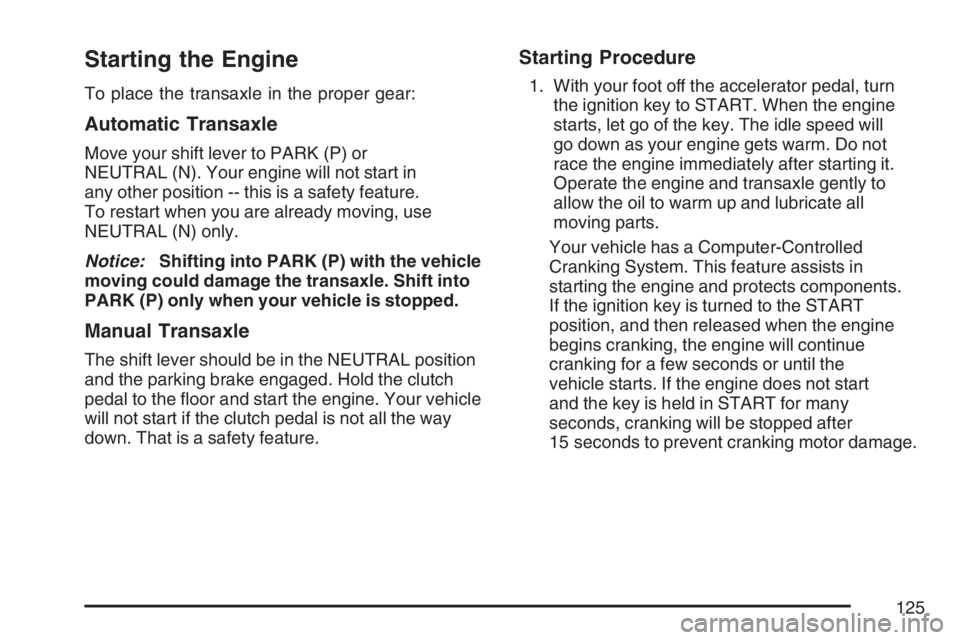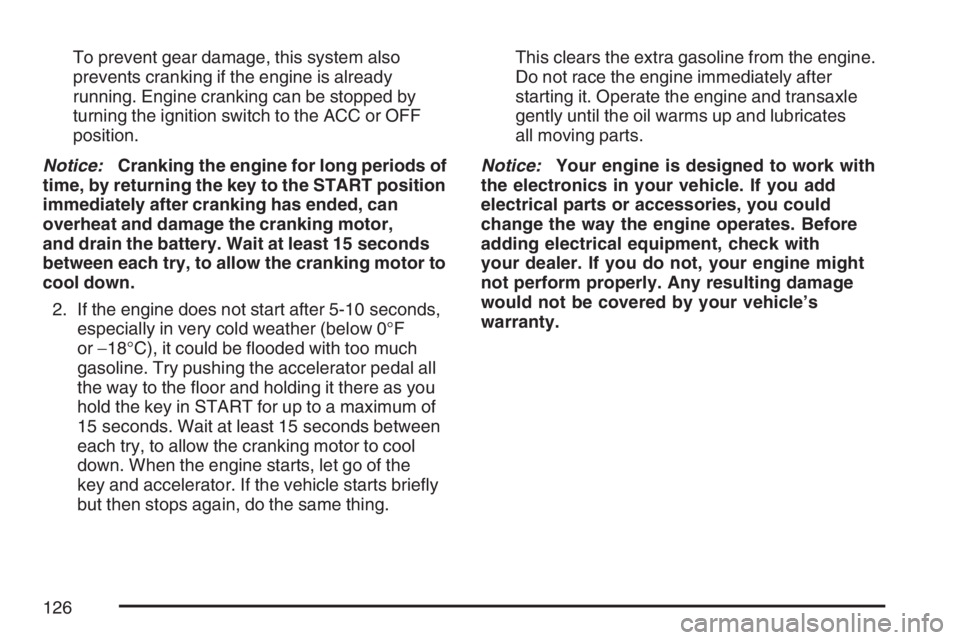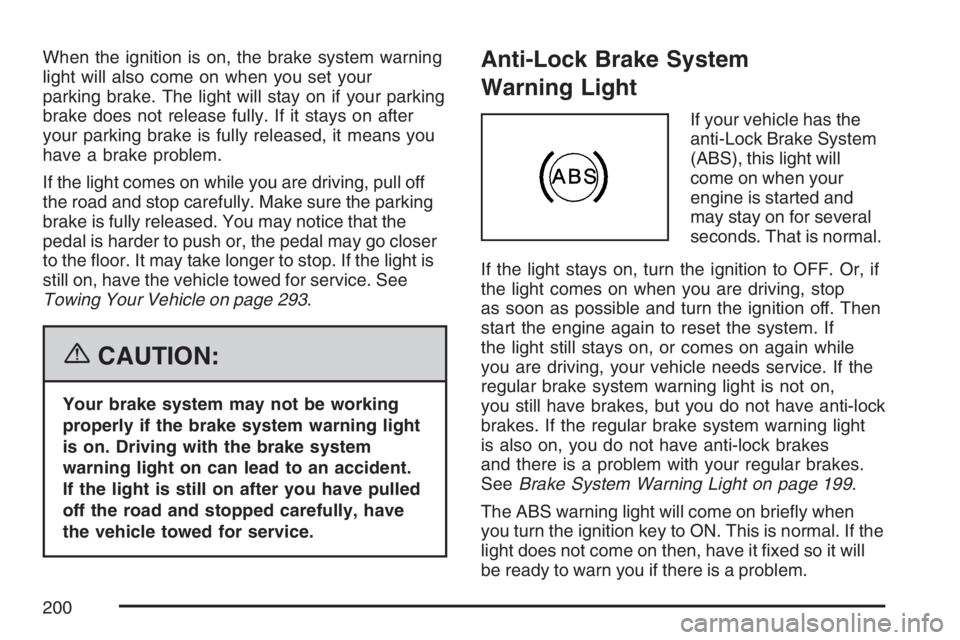stop start PONTIAC G6 2007 Owners Manual
[x] Cancel search | Manufacturer: PONTIAC, Model Year: 2007, Model line: G6, Model: PONTIAC G6 2007Pages: 486, PDF Size: 2.78 MB
Page 12 of 486

Reclining Seatbacks
{CAUTION:
You can lose control of the vehicle if you
try to adjust a manual driver’s seat while
the vehicle is moving. The sudden
movement could startle and confuse you,
or make you push a pedal when you do
not want to. Adjust the driver’s seat only
when the vehicle is not moving.
{CAUTION:
If the seatback is not locked, it could
move forward in a sudden stop or crash.
That could cause injury to the person
sitting there. Always push and pull on the
seatback to be sure it is locked.Your seats have manual reclining seatbacks. The
lever used to operate them is located on the
outboard side of the seats.
4-door Model Shown, 2-door Model Similar
12
Page 122 of 486

Starting and Operating Your
Vehicle
New Vehicle Break-In
Notice:Your vehicle does not need an
elaborate break-in. But it will perform better in
the long run if you follow these guidelines:
Do not drive at any one constant speed, fast
or slow, for the �rst 500 miles (805 km). Do
not make full-throttle starts. Do not exceed
5,000 engine rpm. Avoid downshifting to
brake, or slow, the vehicle.
Avoid making hard stops for the �rst
200 miles (322 km) or so. During this time
your new brake linings are not yet broken
in. Hard stops with new linings can mean
premature wear and earlier replacement.
Follow this breaking-in guideline every time
you get new brake linings.
Do not tow a trailer during break-in. See
Towing a Trailer on page 296for the trailer
towing capabilities of your vehicle and more
information.Following break-in, engine speed and load can
be gradually increased.
Ignition Positions
With the key in the
ignition switch, you can
turn it to four different
positions.
Notice:Using a tool to force the key from the
ignition switch could cause damage or break
the key. Use the correct key and turn the key
only with your hand. Make sure the key is in all
the way. If none of this works, then your vehicle
needs service.
122
Page 125 of 486

Starting the Engine
To place the transaxle in the proper gear:
Automatic Transaxle
Move your shift lever to PARK (P) or
NEUTRAL (N). Your engine will not start in
any other position -- this is a safety feature.
To restart when you are already moving, use
NEUTRAL (N) only.
Notice:Shifting into PARK (P) with the vehicle
moving could damage the transaxle. Shift into
PARK (P) only when your vehicle is stopped.
Manual Transaxle
The shift lever should be in the NEUTRAL position
and the parking brake engaged. Hold the clutch
pedal to the �oor and start the engine. Your vehicle
will not start if the clutch pedal is not all the way
down. That is a safety feature.
Starting Procedure
1. With your foot off the accelerator pedal, turn
the ignition key to START. When the engine
starts, let go of the key. The idle speed will
go down as your engine gets warm. Do not
race the engine immediately after starting it.
Operate the engine and transaxle gently to
allow the oil to warm up and lubricate all
moving parts.
Your vehicle has a Computer-Controlled
Cranking System. This feature assists in
starting the engine and protects components.
If the ignition key is turned to the START
position, and then released when the engine
begins cranking, the engine will continue
cranking for a few seconds or until the
vehicle starts. If the engine does not start
and the key is held in START for many
seconds, cranking will be stopped after
15 seconds to prevent cranking motor damage.
125
Page 126 of 486

To prevent gear damage, this system also
prevents cranking if the engine is already
running. Engine cranking can be stopped by
turning the ignition switch to the ACC or OFF
position.
Notice:Cranking the engine for long periods of
time, by returning the key to the START position
immediately after cranking has ended, can
overheat and damage the cranking motor,
and drain the battery. Wait at least 15 seconds
between each try, to allow the cranking motor to
cool down.
2. If the engine does not start after 5-10 seconds,
especially in very cold weather (below 0°F
or−18°C), it could be �ooded with too much
gasoline. Try pushing the accelerator pedal all
the way to the �oor and holding it there as you
hold the key in START for up to a maximum of
15 seconds. Wait at least 15 seconds between
each try, to allow the cranking motor to cool
down. When the engine starts, let go of the
key and accelerator. If the vehicle starts brie�y
but then stops again, do the same thing.This clears the extra gasoline from the engine.
Do not race the engine immediately after
starting it. Operate the engine and transaxle
gently until the oil warms up and lubricates
all moving parts.
Notice:Your engine is designed to work with
the electronics in your vehicle. If you add
electrical parts or accessories, you could
change the way the engine operates. Before
adding electrical equipment, check with
your dealer. If you do not, your engine might
not perform properly. Any resulting damage
would not be covered by your vehicle’s
warranty.
126
Page 130 of 486

You have to apply your regular brake �rst and then
press the shift lever button before you can shift from
PARK (P) while the ignition key is in ON. If you
cannot shift out of PARK (P), ease pressure on the
shift lever and push the shift lever all the way into
PARK (P) as you maintain brake application. Press
the shift lever button and then move the shift lever
into another gear. SeeShifting Out of Park (P)
(Automatic Transaxle) on page 138later in this
section.
REVERSE (R):Use this gear to back up.
Notice:Shifting to REVERSE (R) while your
vehicle is moving forward could damage the
transaxle. The repairs would not be covered by
your warranty. Shift to REVERSE (R) only after
your vehicle is stopped.
To rock your vehicle back and forth to get out of
snow, ice, or sand without damaging your
transaxle, seeIf Your Vehicle is Stuck in Sand,
Mud, Ice, or Snow on page 287.NEUTRAL (N):In this position, your engine does
not connect with the wheels. To restart when
you are already moving, use NEUTRAL (N) only.
Also, use NEUTRAL (N) when your vehicle is
being towed.
{CAUTION:
Shifting into a drive gear while your
engine is running at high speed is
dangerous. Unless your foot is �rmly on
the brake pedal, your vehicle could move
very rapidly. You could lose control and
hit people or objects. Do not shift into a
drive gear while your engine is running at
high speed.
Notice:Shifting out of PARK (P) or
NEUTRAL (N) while the engine is running at
high speed may damage the transaxle. The
repairs would not be covered by your warranty.
Be sure the engine is not running at high
speeds when shifting your vehicle.
130
Page 133 of 486

The transaxle will only allow you to shift into gears
appropriate for the vehicle speed and engine
revolutions per minute (RPM):
The transaxle will not automatically shift to the
next higher gear if the engine RPM is too high.
The transaxle will not allow shifting to the next
lower gear if the engine RPM is too high.
If the vehicle does not respond to a gear change, or
detects a problem with the transaxle, the range of
gears may be reduced and the Malfunction
Indicator Lamp will come on. SeeMalfunction
Indicator Lamp on page 204for more information.
SECOND (2)/THIRD (3)
Gear Start Feature
Notice:If you attempt a third gear start while
trailering or towing a heavy load, you will notice
reduced engine power. This could overheat and
damage your transaxle. Do not attempt a third
gear start while trailering or towing your
vehicle.If your vehicle has the 6-speed transaxle, when
accelerating your vehicle from a stop in snowy
and icy conditions, you may want to shift into
SECOND (2), or THIRD (3) gear. A higher gear,
and light application of the gas pedal, may allow
you to gain more traction on slippery surfaces.
With the TAP-Shift feature, the vehicle can
accelerate from a stop in SECOND (2) or
THIRD (3).
1. Move the shift lever from DRIVE (D) into the
MANUAL MODE (M) position.
2. With the vehicle stopped, press the plus (+)
paddle forward to select SECOND (2) or
THIRD (3)gear. The vehicle will start
from a stop position in SECOND (2) or
THIRD (3)gear.
3. Once the vehicle is moving select the desired
drive gear.
133
Page 134 of 486

Manual Transaxle Operation
This is your shift pattern.
The clutch must be fully
pressed in when shifting
a manual transaxle to
ensure the transaxle is
fully in gear.
Here is how to operate your transaxle:
FIRST (1):Press the clutch pedal and shift into
FIRST (1). Then, slowly let up on the clutch pedal
as you press the accelerator pedal.
You can shift into FIRST (1) when you are going
less that 20 mph (32 km/h). If you have come to a
complete stop and it is hard to shift into FIRST (1),
put the shift lever into NEUTRAL and let up on the
clutch. Press the clutch pedal back down. Then shift
into FIRST (1).SECOND (2):Press the clutch pedal as
you let up on the accelerator pedal and shift into
SECOND (2). Then, slowly let up on the clutch
pedal as you press the accelerator pedal.
THIRD (3), FOURTH (4), and FIFTH (5) and
SIXTH (6):Shift into THIRD (3), FOURTH (4) and
FIFTH (5) and SIXTH (6) the same way you do
for SECOND (2). Slowly let up on the clutch pedal
as you press the accelerator pedal.
To stop, let up on the accelerator pedal and press
the brake pedal. Just before the vehicle stops,
press the clutch pedal and the brake pedal,
and shift to Neutral.
NEUTRAL:Use this position when you start or
idle your engine.
REVERSE (R):To back up, press down the
clutch pedal and lift up on the ring on the shift lever
to shift into REVERSE (R). Let up on the clutch
pedal slowly while pressing the accelerator pedal.
Notice:Shifting to REVERSE (R) while your
vehicle is moving forward could damage the
transaxle. The repairs would not be covered by
your warranty. Shift to REVERSE (R) only after
your vehicle is stopped.
134
Page 170 of 486

9(Off):Move the lever to this position to turn off
the windshield wipers.
&(Intermittent; Speed Sensitive
Wipers):Move the lever to this position for
intermittent or speed sensitive operation. When
you select this position, the delay will vary
depending on the vehicles speed, as well as, the
manually selected delay.
x(Delay):When the lever is in the intermittent
position, turn the intermittent adjust band with
this symbol on it up or down to set for a shorter or
longer delay between wipes. To the left of the
adjust band are bars, increasing in size from
bottom to top, that indicate the frequency of the
wipes. Smaller bars mean the wipers movement is
less frequent. Larger bars mean the movement
is more frequent.
6(Low Speed):Move the lever up to the
�rst setting past intermittent, for steady wiping at
low speed.
1(High Speed):Move the lever up to the
second setting past intermittent, for wiping at high
speed.
8(Mist):Move the lever all the way down to
this position for a single wiping cycle. Hold it there
until the windshield wipers start; then let go.
The windshield wipers will stop after one wiping
cycle. If you want additional wiping cycles, hold the
lever down longer.
Damaged wiper blades may prevent you from
seeing well enough to drive safely. To avoid
damage, be sure to clear ice and snow from the
wiper blades before using them.
If the wiper blades are frozen to the windshield,
carefully loosen or thaw them. If your blades
do become damaged, get new blades.
Heavy snow or ice can overload your wiper motor.
A circuit breaker will stop the motor until it
cools. Clear away snow or ice to prevent an
overload. If the motor gets stuck, turn the wipers
off, clear away the snow or ice, and then turn
the wipers back on.
As an added safety feature, if the wipers are on
for more than 15 seconds, the vehicle’s headlamps
will turn on automatically. They will turn off
15 seconds after the wipers are turned off.
170
Page 200 of 486

When the ignition is on, the brake system warning
light will also come on when you set your
parking brake. The light will stay on if your parking
brake does not release fully. If it stays on after
your parking brake is fully released, it means you
have a brake problem.
If the light comes on while you are driving, pull off
the road and stop carefully. Make sure the parking
brake is fully released. You may notice that the
pedal is harder to push or, the pedal may go closer
to the �oor. It may take longer to stop. If the light is
still on, have the vehicle towed for service. See
Towing Your Vehicle on page 293.
{CAUTION:
Your brake system may not be working
properly if the brake system warning light
is on. Driving with the brake system
warning light on can lead to an accident.
If the light is still on after you have pulled
off the road and stopped carefully, have
the vehicle towed for service.
Anti-Lock Brake System
Warning Light
If your vehicle has the
anti-Lock Brake System
(ABS), this light will
come on when your
engine is started and
may stay on for several
seconds. That is normal.
If the light stays on, turn the ignition to OFF. Or, if
the light comes on when you are driving, stop
as soon as possible and turn the ignition off. Then
start the engine again to reset the system. If
the light still stays on, or comes on again while
you are driving, your vehicle needs service. If the
regular brake system warning light is not on,
you still have brakes, but you do not have anti-lock
brakes. If the regular brake system warning light
is also on, you do not have anti-lock brakes
and there is a problem with your regular brakes.
SeeBrake System Warning Light on page 199.
The ABS warning light will come on brie�y when
you turn the ignition key to ON. This is normal. If the
light does not come on then, have it �xed so it will
be ready to warn you if there is a problem.
200
Page 205 of 486

This light should come on, as a check to show
you it is working, when the ignition is on and the
engine is not running. If the light does not
come on, have it repaired. This light will also
come on during a malfunction in one of two ways:
Light Flashing— A mis�re condition has
been detected. A mis�re increases vehicle
emissions and may damage the emission
control system on your vehicle. Diagnosis and
service may be required.
Light On Steady— An emission control
system malfunction has been detected on your
vehicle. Diagnosis and service may be
required.
If the Light is Flashing
The following may prevent more serious damage
to your vehicle:
Reducing vehicle speed
Avoiding hard accelerations
Avoiding steep uphill grades
If you are towing a trailer, reduce the amount
of cargo being hauled as soon as it is
possibleIf the light stops �ashing and remains on steady,
see “If the Light Is On Steady” following.
If the light continues to �ash, when it is safe to do
so, stop the vehicle. Find a safe place to park
your vehicle. Turn the key off, wait at least
10 seconds and restart the engine. If the light
remains on steady, see “If the Light Is On Steady”
following. If the light is still �ashing, follow the
previous steps, and see your dealer for service as
soon as possible.
If the Light Is On Steady
You may be able to correct the emission system
malfunction by considering the following:
Did you recently put fuel into your vehicle?
If so, reinstall the fuel cap, making sure to fully
install the cap. SeeFilling the Tank on page 313.
The diagnostic system can determine if the
fuel cap has been left off or improperly installed.
A loose or missing fuel cap will allow fuel to
evaporate into the atmosphere. A few driving trips
with the cap properly installed should turn the
light off.
205